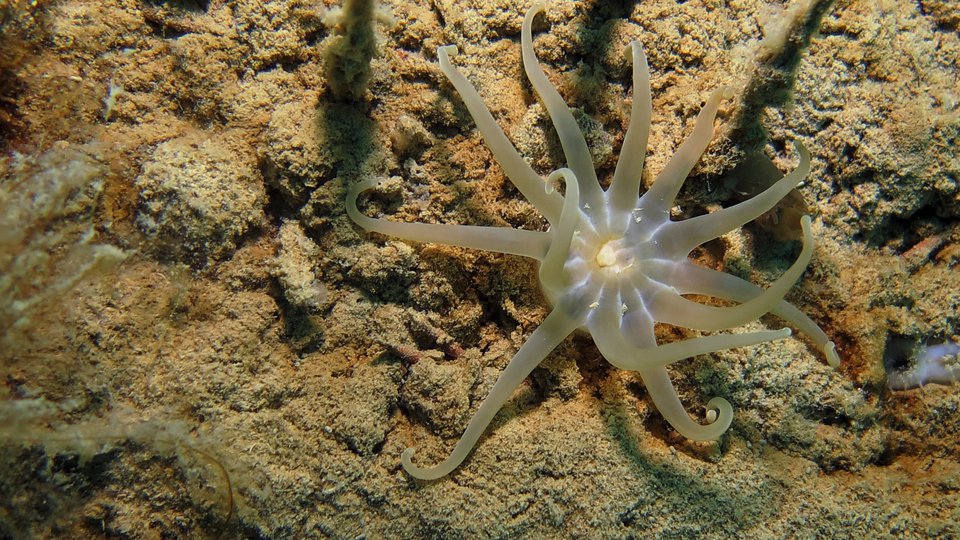
rctic Char and Lake Trout are distributed across the Canadian Arctic, including in many lakes and rivers on Victoria Island, Nunavut. For millennia these two species have been a critically important resource for Inuit in Nunavut’s Kitikmeot region, especially the sea-run variant of Arctic Char which entirely supports the current commercial fishery in the Cambridge Bay area. For the past half century, our understanding of the biology of Arctic Char and Lake Trout in the Kitikmeot region has relied primarily on the analyses of trends in biological characteristics. Recently, however, the incorporation of modern fish tracking techniques has significantly advanced our understanding of the life history and ecology of these species, the results of which will be key for refining fisheries management practices aimed at ensuring the sustainable harvest of this culturally and commercially important resource.
Despite these advancements in the collective understanding of local Arctic Char and Lake Trout biology, one key knowledge gap that still remains is our overall understanding of their freshwater movements within the large watersheds that characterize the region. Thus, for the past six years a team of researchers led by Dr. Jean-Sébastien Moore (Université Laval) and Les Harris (Fisheries and Oceans Canada) have been tracking the movements of Arctic Char throughout the Kitikmeot region’s Ekallulk River watershed. The following is a summary blog of our 2018 field season.
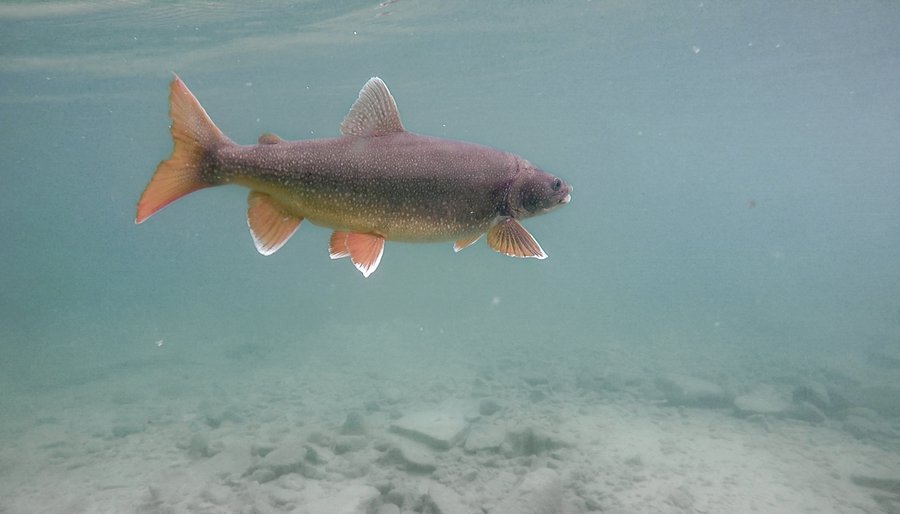
A Lake Trout swimming away after having an acoustic transmitter surgically implanted minutes ago. Photo by Brendan Malley
Before we get started, let me explain a few things about tracking fish. In brief, fish are tracked using acoustic telemetry, the key elements of which are acoustic transmitters and receivers. Transmitters are small electronic tags, roughly the size of an AA battery, that transmit a unique ID via a series of “pings” into the surrounding water. We surgically implant these tags into the body cavity of the fish and in ideal conditions, they can be “heard” by a receiver sometimes more than a kilometer away. Receivers are our listening devices. Essentially, they are relatively small, data-logging computers anchored near the bottom of the water column “listening” for our tagged fish. When a signal emitted by a transmitter is received, the tag’s unique ID code is saved, along with a date and time. As such, we know exactly when a tagged fish is detected. With many receivers deployed over a large region, we can retrace a fish’s movement pattern.
An extension of this, the Vemco Positioning System (VPS) which you’ll hear about later, determines the fish’s exact positions for the duration of a study using an array of several closely located receivers. The VPS uses differences in time it takes for the signal from an individual tag to be “heard” by three or more receivers. Using these differences in time, the position of a fish can be triangulated, typically within a few meters of their true location. The result is a series of “tracks” for each fish throughout the duration of the study that can provide a unique and very precise understanding of behavior and habitat use.
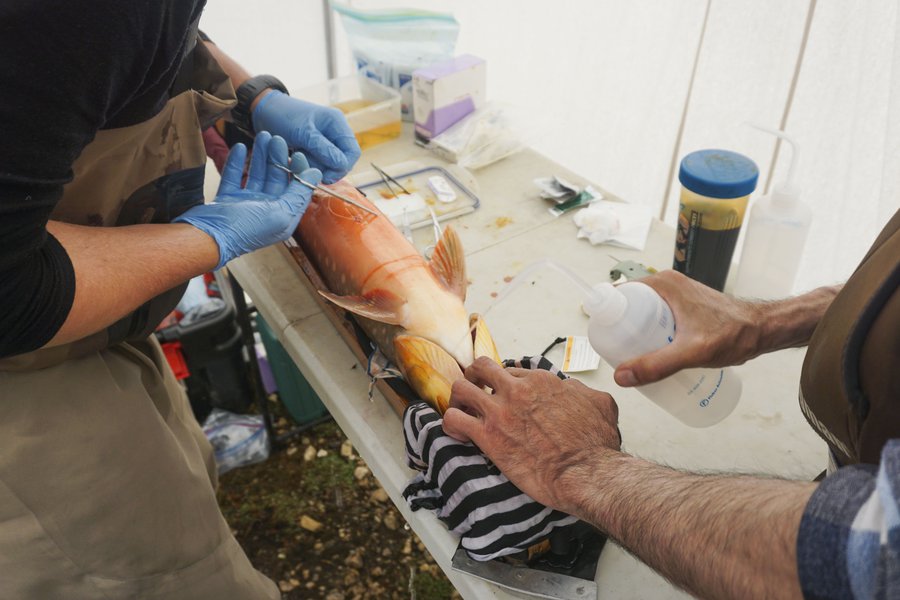
An Arctic char on the surgergy table. Photo by Les Harris.
It’s nearing the end of July; the start of another six weeks of flying around in float planes, ATV-ing across the unforgiving tundra, recovering and re-deploying receivers, setting up camps, downloading data and surgically implanting transmitters into fish. It would be business as usual, except this time Les is late, without luggage and on his own for several weeks. The perfect start to a field season. Oh, and one of our primary goals for the summer was to deploy our first VPS using 42 acoustic receivers.
The lake we initially chose to attempt the first VPS study known for Arctic Char is situated in the Ekalluk River watershed, roughly 1 km from the south shore of the largest lake (Ferguson Lake) on Victoria Island. This lake, known locally as “Spawning Lake”, is 7 km long and 4 km wide. In the past, we have successfully tagged both Arctic Char and Lake Trout in the lake and in 2017 we spent 4 days mapping it’s bathymetry (lake bottom topography) and electrofishing for juvenile Arctic Char (for genetic samples). The lake has been in our minds for years, and at the forefront of our offseason planning. As with all arctic field research, countless hours were spent in the last year conceptualizing, designing and carefully planning our study in order to get the most out of the short season afforded by the Arctic climate.This year, however, the Arctic had other plans for researchers. A late thaw, in combination with unusually high amounts of rainfall and persistently strong winds can derail even the finest of plans. After spending another “average windy” day (~30 km/h) retrieving and deploying receivers off the side of a float plane, Les had some thinking to do as it was becoming quite clear that the chances of completing Plan A were looking grim.
Over a cup of tea, he voiced to our good friend and phenomenal local field assistant, Richard Ekpakohak, that things were not looking good for a VPS study on Spawning Lake. He explained that the persistent winds would be detrimental to our season given the size of Spawning Lake and the limitations of our main vessel, a 10ft inflatable boat (the RV Patches O’houlihan). Without delay, Richard dug into his enormous data base of local knowledge, pulling out two smaller, more manageable lakes given the untiring winds. However, neither of these lakes were in our familiar Ekalluk system, but rather they were located in the Grenier Lake system much closer to the community of Cambridge Bay. Logistically this was certainly better, however, Les had reservations given we were not at all familiar with these bodies of water. Richard assured Les that both lakes had the essential characteristics required for our study; spawning Arctic Char and Lake Trout, sufficient depths for deploying our equipment and impassable inflows and outflow ensuring all tagged fish would remain there until spring-break up. These lakes were also accessible by ATV (new to us) which was a welcome bonus. After a quick call south to discuss the revised plan, I was quickly hustling to obtain the necessary approvals and support, amend research licenses, and design the two new VPS arrays. All this needed to be completed before flying north a couple days later (to the land of slow internet).

Richard Ekpakohak enjoying his time out on the land, photo by Brendan Malley
Luckily, we were able to assemble the “dream team” for this field season, consisting of Les Harris, Maude Sévigny (MSc Student, Université Laval), Matt Gilbert (PhD Student, University of British-Colombia), Richard Ekpakohak, Meyok Omilgoitok (long-time field assistant) and myself (MSc Student, University of Manitoba). Fast forwarding through a week of packing and waiting out winds we finally set out with a load by ATV to Inuhuktuk Lake. Not long into our trip we break an axle on one of our ATV trailers. A few ratchet straps and a return trip to town to drop off the now useless trailer and we continue on.
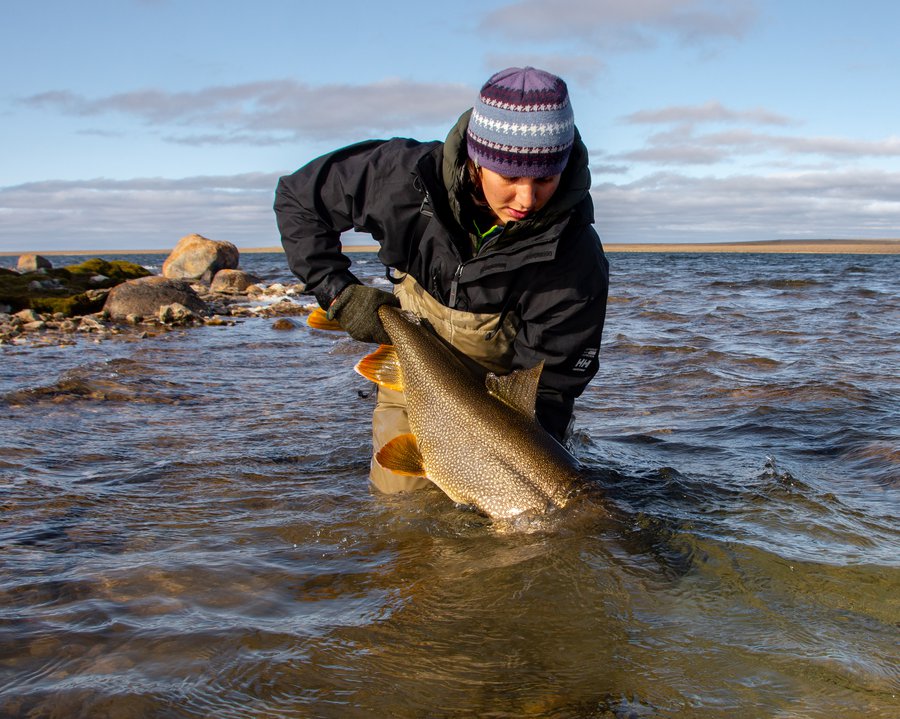
Maude Sévigny of Université Laval releasing a giant Lake Trout at Nakyulik Lake. Photo by Brendan Malley.
After a few days of float plane debilitating winds, we set out with the last of our overloaded ATVs, and jam-packed plane loads. The to-do lists for Inuhuktuk and Nakyulik Lake were lengthy and undoubtedly ambitious. We wanted to tag Arctic Char and Lake Trout in spawning condition with both tracking tags and oviduct tags (a small tag inserted into the females oviduct and later dropped during spawning, allowing for the precise, pin–pointing of spawning locations), create bathymetric maps (maps that show the topography of the bottom of a lake) and deploy our first VPS arrays. Pushing forward through boat punctures, another broken trailer, rain, snow, and of course wind, we were successful. While catch rates were slower than expected for Char, combining “hot picking” gill nets (continuously checking a gill net for fish) and angling got the job done. At this point our team splits in two, with Les, Matt and Richard heading back to town to organize some receiver deployment days throughout the Grenier system. The now “three amigos” take down camp, load up the planes, and move on to Nakyulik Lake.
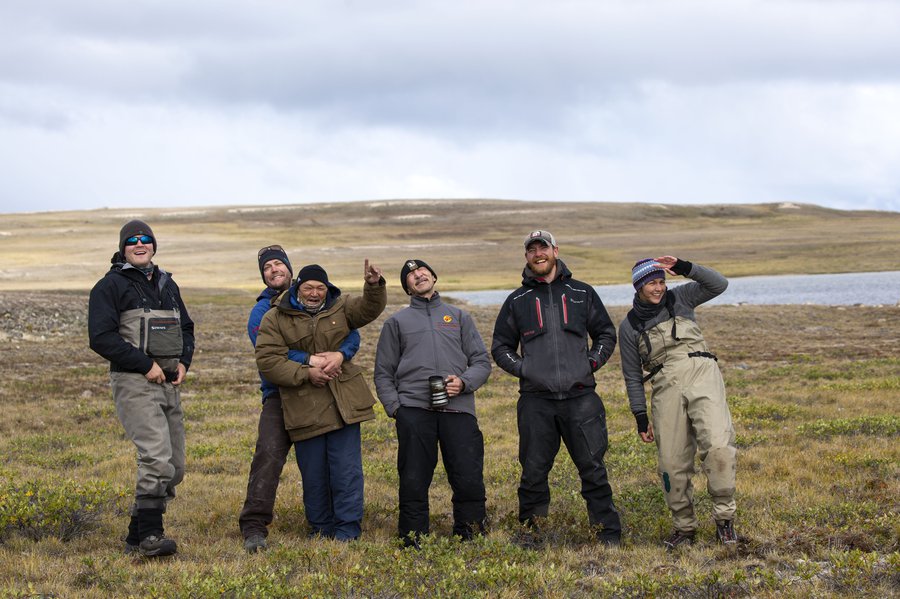
“The Dream Team”, Left to Right: Brendan Malley, Les Harris, Richard Ekpakohak, Meyok Omilgoitok, Matt Gilbert, Maude Sévigny, Photo by Zachary Prong.
With half the team and a lake five times the size as the last, we had countless hours of work ahead of us. Upon arriving, I spotted a “flat looking” point in the middle of the lake from the plane and decided that would be our camp spot. Flat is a relative term when it comes to the Arctic tundra. Although it was far from the ideal camping spot, the three of us were each able to find comfy divots nestled between the hummocks. The next morning we got to work bright and early, setting nets and finishing setting up camp. Unfortunately, and much to our chagrin, Char catch rates started off slow, again. With only one Char caught all day, we were getting concerned. That evening, soaking wet, uncomfortably cold, and with only one Char in our holding pens, I set out to start mapping the lake and perhaps reevaluate our plan (and maybe some life choices). Luckily, amidst my moping, I stumble across a group of spawning Char, which, with their glowing orange coloration, can unmistakably be seen through the crystal clear water. We immediately relocated the nets and stayed up until 1:00am checking them before reluctantly pulling them out for the night. We finish the day with five beautiful Char and all the Lake trout we needed for the study.
The next day, we finish catching the rest of the Char needed and prep our 24 receivers for deployment. The following day Meyok packs a lunch and jumps in the boat to put in a full day of mapping. Meanwhile, Maude and I complete all 25 surgeries, successfully releasing some of the largest Char and Trout we have ever tagged. The subsequent morning is spent making anchors (our supremely sophisticated 80-100lb mesh rock bags). The afternoon and evening was spent deploying every last receiver from the RV Patches O’houlihan. After a few more days of mapping, and inserting the last of our oviduct tags we are done with camp life for the summer. Despite the harsh conditions, long days, and lack of sleep, we load the planes one last time, smiling more now than ever before. For some 2018 will be remembered as the summer of gruelling weather and disappointment. For us, it will be the year we bent but didn’t break.

Brendan Malley with a spawning Arctic char. Photo by Matthew Gilbert.

